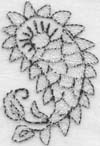Section 16 == *script chart*; *positional chart*; *more help*
16.1 = Recognizing word sources
==ARABIC WORDS: Words containing the following letters are virtually always drawn from Arabic: ṡe , ḥe , ṣvād , ẓvād , t̤oʾe , z̤oʾe , ʿain , qāf
==ARABIC OR PERSIAN WORDS: Words containing the following letters may be either Arabic or Persian: ḳhe , żāl , ze , ġhain
==PERSIAN WORDS: Words containing zhe definitely come from Persian.
==PERSIAN OR INDIC WORDS: Words containing the letters pe , or che , or gāf , may be of either Persian or Indic origin.
==INDIC WORDS: Words containing the retroflex consonants ṭe , or ḍāl , or ṛe , and those containing aspirated sounds achieved with do-chashmī he , are definitely Indic in origin.
==ENGLISH WORDS: Remember: words that contain a large number of retroflex sounds, or that simply look very odd and counterintuitive, may just come from English.
16.2 = from Devanagari to Urdu
script: the changes
Obvious changes include the loss of the distinct Devanagari retroflex letters "Na" and "SHa," which cannot be distinguished from ordinary nūn and shīn in Urdu. Also lost is the special Sanskritic "rí" vowel, as in "KríSHNa," which turns into ordinary re with-- very optionally, of course-- a zer beneath it. And as we have seen, many other spelling distinctions come in: the four different "z" letters ze , żāl , ẓvād , and z̤oʾe ; the three different "s" letters sīn , ṣvād , ṡe ; the two dental "t" letters te and t̤oʾe .
There is also the elusive wild-card vowel ʿain , which cannot be marked or distinguished in Devanagari but assumes considerable importance in Urdu. And the independent sounds of ḳhe , ġhain , fe , qāf become much more obvious now that they are no longer shown merely by (sometimes omitted) dots under "kha," "ga," "pha," and "ka" respectively.
In a number of words,
Devanagari short vowels tend to turn into long ones in
Urdu, probably because Urdu does not excel at
representing short vowels. Town names that end in "-pur"
in Devanagari tend to end in pūr
in Urdu. Words with word-final short vowels in
Devanagari tend to acquire word-final long vowels in
Urduu: "pati" (husband) becomes patī
in Urdu, "bhakti" becomes bhaktī
, and so on. (In fact, at the end of a word it's very
awkward indeed to try to show a short vowel sound.)
Also take note of the perfect forms of honā . They are all pronounced just as they should be, but they are spelled with long vowels in the first syllable where you would expect short ones. In Urduu "huaa" is spelled he plus vāʾo plus alif , with-- by a special, quirky convention-- no hamzah . The other forms are spelled with he plus vāʾo plus hamzah plus either baṛī ye (masc pl.), chhoṭī ye (fem. sing.), or chhoṭī ye plus nūn-e ġhunnah (fem. pl.).
Of course the special Sanskritic consonant-cluster letters "ks:h," "dya," and "gya" break down into sequences of regular letters. The same is true of consonant clusters in general. Thus kyā (what) tends to look just like kiyā (did); although it could be distinguished by the use of a jazm (see section 5.2) over the kāf , it very often isn’t.
In Urdu, initial consonant clusters are very rare; in fact, officially they do not occur at all. Thus Indic words like "prachaar," "prajaa," etc. normally become "parchaar" and parjaa" (and are scanned that way in poetry too). Even within the word, Indic consonant clusters tend to break down: thus "Indra" tends to become "Indar." However, there are some exceptions in practice: "KríSNa" normally becomes, in pronunciation, "Krishan" rather than "Kirshan." Borrowed English words like "station" and "school" traditionally lose their initial consonant clusters and turn into isṭeshan and iskūl . However, nowadays some speakers make a point of maintaining the initial consonant cluster: sṭeshan , skūl .
16.3 = Common Persian and Arabic
forms
The most detailed discussion
I've seen is in M. A. R. Barker's
excellent overviews, from vol. 2 of A Course in Urdu
(1967), of the *Persian
elements* and *Arabic
elements* used in Urdu. Don't be put off by their
elaborateness, or by the unusual transliteration system.
If you want to prepare yourself for serious-- especially
older-- literary Urdu, and save yourself a lot of
dictionary work, they are well worth the effort.
If you're an advanced student working with
classical poetry, here's
a really nice help: a small *handbook
of Persian verb forms*, presented from an Urduized
perspective.
Even if you're not that motivated, however, you'll find that a small number of Arabic verbal patterns are extremely common in Urdu. It's especially valuable to learn to recognize some of them, since it saves really a remarkable amount of dictionary work. Here are some examples of a few very common ones (more can be found in Barker's overview):
| n z̤ r | intiz̤ār , "wait" (look out for) naz̤ar , "look" manz̤ar , "scene" manz̤ūr , "desired, accepted" (looked for) |
| n z̤ m | nāz̤im , "composer, arranger,
administrator" niz̤ām , "arrangement, arranger" naz̤m , "poem" intiz̤ām , "arrangement" manz̤ūm , "versified" |
| k t b | kātib , "calligrapher" kitāb , "book" maktab , "school" kutb-ḳhānah , "library" maktūb , "manuscript" |
| ʿ l m | ʿālim
, "knower" (plural: ʿulamā
, "knowers") ʿilm , "knowledge" maʿlūm , "known" |
| ʿ sh q | ʿāshiq
, "lover" ʿishq , "passion, love" maʿshūq , "beloved" |
| s j d | sājid , "prostrator" sijdah , "prostration" masjid , "place of prostration" masjūd , "prostration-receiver" |
| ʿ b d | ʿābid , "worshipper" ʿibādat , "worship" maʿbūd , "worshipped" |
| t̤ l b | t̤ālib
, "seeker" (pl. t̤ālibān
, "seekers") mat̤lab , "meaning, intention" mat̤lūb , "sought" |
